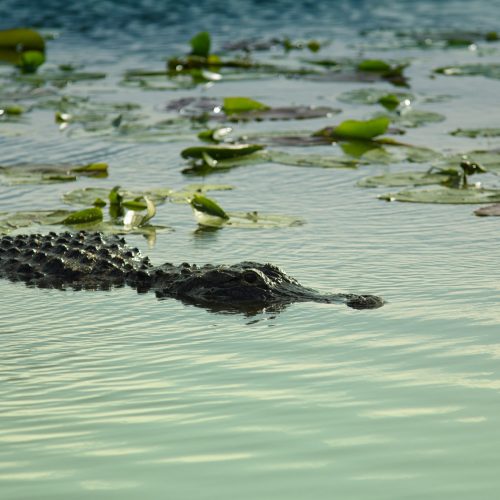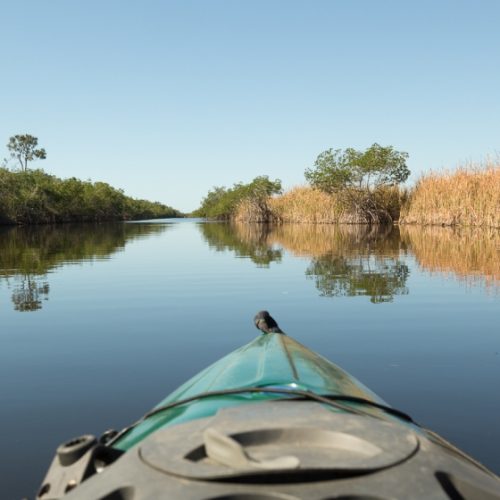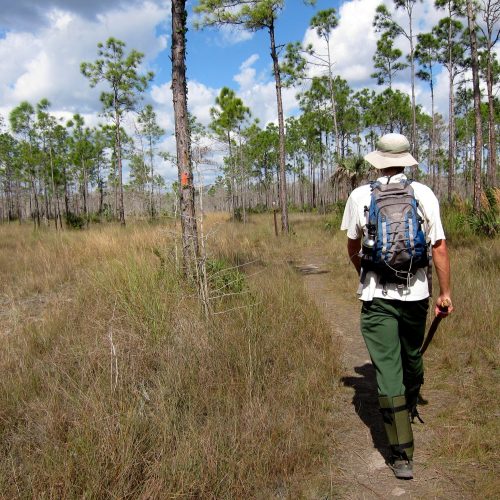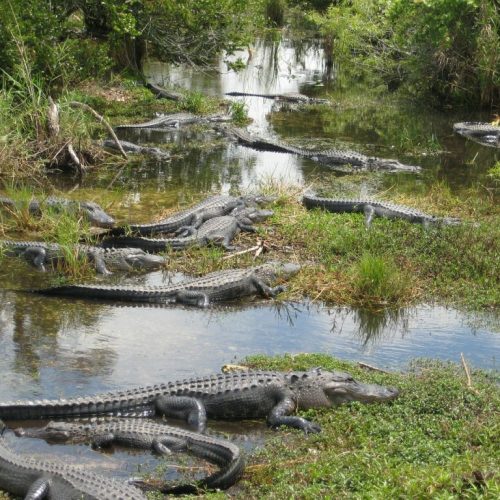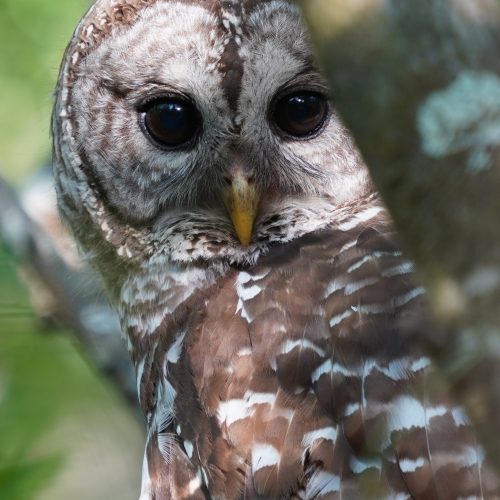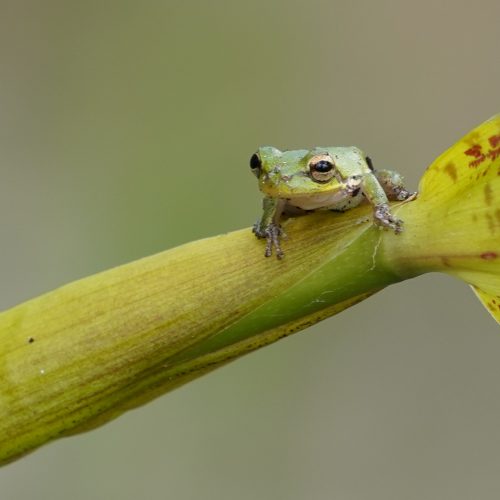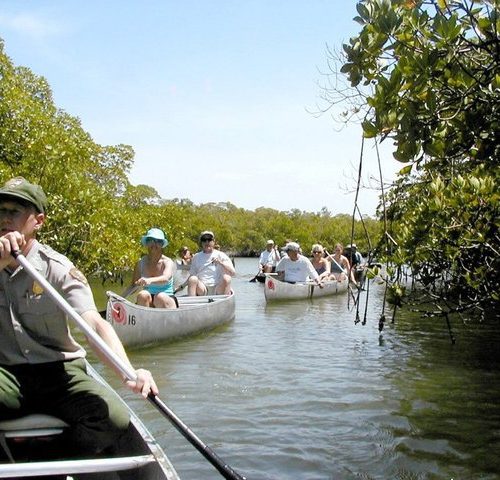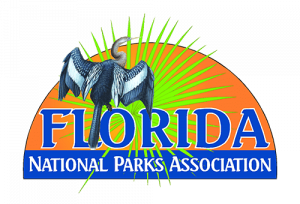From the Glades peoples, two major nations emerged in the area: the Calusa and the Tequesta. The Calusa was the largest and most powerful nation in South Florida. It controlled fifty villages located on Florida’s west coast, around Lake Okeechobee, and on the Florida Keys. Most Calusa villages were located at the mouths of rivers or on key islands. The Calusa were hunter-gatherers who lived on small game, fish, turtles, alligators, shellfish, and various plants. Most of their tools were made of bone or teeth, although sharpened reeds were also effective for hunting or war. Calusa weapons consisted of bows and arrows, atlatls, and spears. Canoes were used for transportation, and South Florida tribes often canoed through the Everglades, but rarely lived in them. Canoe trips to Cuba were also common.
Estimated numbers of Calusa at the beginning of the Spanish occupation ranged from 4,000 to 7,000. The society declined in power and population; by 1697 their number was estimated to be about 1,000. In the early 18th century, the Calusa came under attack from the Yamasee to the north. They asked the Spanish for refuge in Cuba, where almost 200 died of illness. Soon they were relocated again to the Florida Keys.
Second in power and number to the Calusa in South Florida were the Tequesta. They occupied the southeastern portion of the lower peninsula in modern-day Dade and Broward counties. Like the Calusa, the Tequesta societies centered on the mouths of rivers. Their main village was probably on the Miami River or Little River. Spanish depictions of the Tequesta state that they were greatly feared by sailors, who suspected them of torturing and killing survivors of shipwrecks. With an increasing European presence in south Florida, Native Americans from the Keys and other areas began increasing their trips to Cuba. Official permission for the immigration of Native Americans from the Florida Keys was granted by Cuban officials in 1704. Spanish priests attempted to set up missions in 1743, but noted that the Tequesta were under assault from a neighboring tribe. When only 30 members were left, they were removed to Havana. A British surveyor in 1770 described multiple deserted villages in the region where the Tequesta lived. Common descriptions of Native Americans in Florida by 1820 used only the term “Seminoles.”
Following the demise of the Calusa and Tequesta, Native Americans in southern Florida were referred to as “Spanish Indians” in the 1740s, probably due to their friendlier relations with Spain. The Creek invaded the Florida peninsula; they conquered and assimilated what was left of pre-Columbian societies into the Creek Confederacy. They were joined by remnant Indian groups and formed the Seminole, a new tribe, by ethnogenesis. The Seminole originally settled in the northern portion of the territory. In addition, free blacks and fugitive slaves made their way to Florida, where Spain had promised slaves freedom and arms if they converted to Catholicism and pledged loyalty to Spain. These African Americans gradually created communities near those of the Seminole, and became known as the Black Seminoles. The groups acted as allies.
In 1817, Andrew Jackson invaded Florida to hasten its annexation to the United States, in what became known as the First Seminole War. After Florida became a U.S. territory in 1821, conflicts between settlers and the Seminole increased as the former tried to acquire lands. The Second Seminole War lasted from 1835 to 1842, and afterward, the US forcibly removed about 3,000 Seminole and 800 Black Seminole to Indian Territory (now Oklahoma), west of the Mississippi River. Many others died in the war. Conflict broke out again in the Third Seminole War from 1855 to 1859, when a few hundred Seminole fought off US forces from the swamps of the Everglades. The US finally decided to leave them alone, as they could not dislodge them even after this protracted and expensive warfare.
By 1913, the Seminole in the Everglades numbered no more than 325. They made a living by hunting and trading with white settlers, and raised domesticated animals. The Seminole made their villages in hardwood hammocks or pinelands, had diets of hominy and coontie roots, fish, turtles, venison, and small game. Their villages were not large, due to the limited size of the hammocks. Between the end of the last Seminole War and 1930, the people lived in relative isolation from the majority culture.
The construction of the Tamiami Trail, beginning in 1928 and spanning the region from Tampa to Miami, altered their ways of life. Some began to work in local farms, ranches, and souvenir stands. Some of the people who interacted more with European Americans began to move to reservations in the 1940s. These were their bases for reorganizing their government and they became federally recognized in 1957 as the Seminole Tribe of Florida.
People who kept more traditional ways had settlements along the Tamiami Trail and tended to speak the Mikasuki language. They later were federally recognized in 1962 as the Miccosukee Tribe of Indians of Florida. As metropolitan areas in South Florida began to grow, the two groups were closely associated with the Everglades. They struggled to maintain privacy while serving as tourist attractions. They earned money by wrestling alligators and selling craftworks. As of 2008, the Seminole Tribe of Florida had five reservations, and the lands of the Miccosukee Tribe of Indians were collectively considered a sixth reservation. The two tribes have each developed casino gaming on some of their properties to generate revenue for support, services and economic development.

